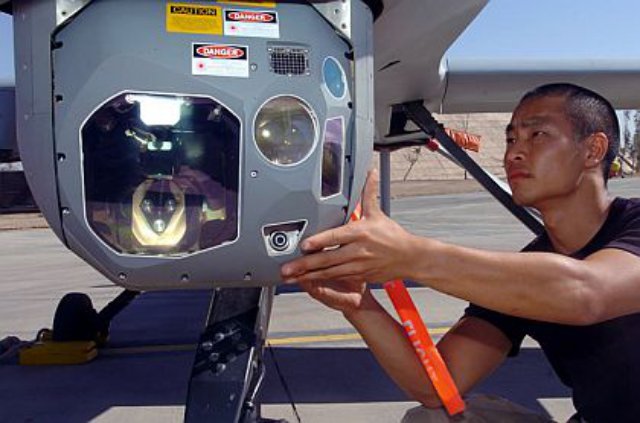U.S. Air Force officials needed electro-optical targeting systems for the General Atomics MQ-9 Reaper hunter-killer unmanned aircraft system (UAS), as well as for manned helicopters and fixed-wing aircraft. They found their solution from the Raytheon Co. Space and Airborne Systems segment in McKinney, Texas.
Officials of the Air Force Life Cycle Management Center Medium Altitude Unmanned Aircraft Systems office at Wright-Patterson Air Force Base, Ohio, awarded Raytheon a $50.2 million contract Monday to provide the Multispectral Targeting System (MTS)-B for the Reaper hunter-killer UAS and for other aircraft.
The contract calls for Raytheon to provide MTS-B turret units, 37 MTS HD electronics units, containers, spare parts, and support equipment. The MTS-B provides electro-optical, infrared, laser designation, and laser illumination packaged in one sensor package.
The MTS-B uses a digital architecture to provide long-range surveillance, high-altitude target acquisition, tracking, rangefinding, and laser designation for the Hellfire missile and for all tri-service and NATO laser-guided munitions, Raytheon officials say. The Raytheon MTS electro-optical sensor family, which also is for the C-130 fixed wing aircraft, the MH-60 helicopter, the Reaper UAV, and other aircraft, have been integrated on more than 16 U.S. military and Department of Homeland Security aircraft, Raytheon officials say. MTS products are flying aboard special mission aircraft for NASA, special operations forces, and coalition fleets around the world.
A turreted or forward-looking pod combining several sensors, the MTS has visible-light and infrared full-motion video cameras for long-range surveillance. The systems offer multiple wavelength sensors; near-infrared and colour TV cameras; target illuminators; eyesafe laser rangefinders; image merging; spot trackers; and other avionics.
The system’s Advanced Targeting Forward Looking Infrared (ATFLIR) pod also is used with Paveway, JSOW, and HARM munitions. The MTS sensors carry the military designations of AAS-52, AAS-53, ASQ-228, DAS-1 and DAS-2.
On the current contract Raytheon will do the work in McKinney, Texas, and should be finished by September 2014.
Source: Military & Aerospace Electronics

